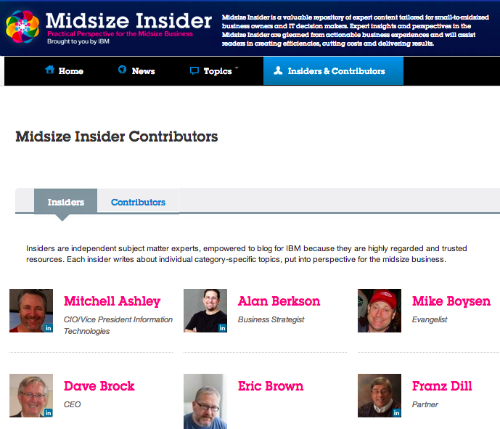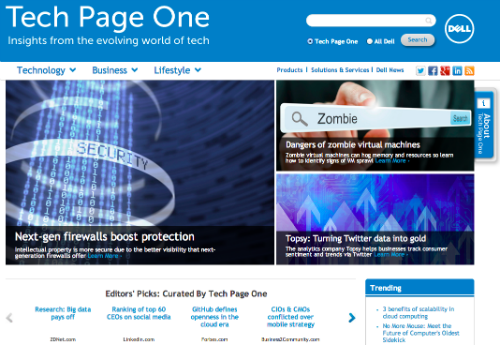 If you work in the B2B marketing world, content is one of the most important tools you have to create awareness, nurture and convert prospects to customers. For proof, look no further than the recent CMI & MarketingProfs industry survey for 2014 that reports 93% of B2B marketers use content marketing.
If you work in the B2B marketing world, content is one of the most important tools you have to create awareness, nurture and convert prospects to customers. For proof, look no further than the recent CMI & MarketingProfs industry survey for 2014 that reports 93% of B2B marketers use content marketing.
Part of gaining confidence in the right direction for your B2B content marketing efforts means asking and answering the right questions. Not just for your potential customers, but internal questions to open doors of consideration for your content marketing strategy.
Here are 5 essential questions many marketers are facing now and my answers to consider. I invite you to think of your own answers and share them in the comments.
What are some common misconceptions about content marketing?
Many companies still think of content marketing solely in terms of creating more content.
In the SEO community, content marketing is a very hot topic, but most SEOs think of it as a link building tactic: Create and promote great content to attract links.
Another limitation people impose on content marketing is to think of it only in terms of content objects, iike webinars, white papers and infographics vs. in terms of outcomes or experiences.
When I’m planning content for a client or for TopRank Online Marketing, not only do I think about the accuracy and compelling aspects of the story, but I also think about how that content can contribute to the overall consumer experience with the brand. How will it make a reader feel? The B’s in BtoB marketing are people too and some types of content are more than appropriate for connecting emotionally with the buyer.
A great example of B2B storytelling that contributes significantly to an experience is GE’s Datalandia
Another is Suitemates from Kinaxis
What kind of resources do you need to build a successful content marketing program?
Many companies considering resources for a content marketing program are not in a position to start hiring dedicated staff, so these suggestions could be considered as additional responsibilities in some cases. Joe Pulizzi and Robert Rose cover content marketing organizational structure pretty well in their book, Managing Content Marketing.
Since we’re in the thick of providing content marketing services for mid-market companies like Strongview and LinkedIn as well as large companies like McKesson and Dell, I’ve been able to get a good picture of what the essential resources need to be – for any company size.
Content leadership – A person who will champion the content cause in the organization. Larger companies will need executive sponsorship for the initiative and this role. For mid market and small companies, this role might be an Editor in Chief hired from the publishing industry. Experience with a media publisher and newsroom is essential as is managing or working with a team of writers, creatives and the business side of publishing. This editorial oversight serves as a steward for the voice of the brand
For a small or medium business, a Content Marketing Manager often fills this role with experience in corporate communications, publishing and marketing.
Content creators – From a brand journalist to copywriters, front end web developers/designers and creative design, the production team is the bread and butter for a content marketing effort. Companies large and small are scaling their content creation efforts not by hiring more pro writers beyond a core team, but by tapping into internal subject matter experts.
Additionally, companies that integrate their content marketing and social media community efforts will be able to connect with external resources for content creation as well. Some of these external resources will be fans and advocates and some will be paid writers and contributors that can create high quality content and share it with their own networks.
A great example of the output of this mix of internal and external content creation resources is Dell’s Tech Page One (Disclosure: Dell is a TopRank client)
Another great example of this is IBM’s Midsize Insider program.

Content Promoters – Great content isn’t great unless people can easily find, consume, share and act on it. That means having the people resources to promote the content being created, whether it’s traditional fare like white papers, eBooks and infographics or interactive social media content.
Content Amplification is something that should be factored in at the content planning level. We encourage our content creators to promote the content they’re producing and offer some performance metrics so they can see evidence of their work having impact. This feedback loop is critical for ongoing content performance optimization and can be highly motivating for content producers.
Organic amplification can be accomplished through SEO, social networks, blogger outreach and media relations. Paid amplification can be accomplished through PPC ads, social network ads, sponsored content and native advertising and other paid placement.
Monitoring and Analytics – From social media monitoring to web analytics, the performance of content can’t be left simply to page views and search engine rankings. While it may make sense for a company to have dedicated analytics and monitoring resources, we believe in cross training content and account staff on these skills. For example, Eliza Steely, Ben Brausen and Steven Zahurones from our team recently become Google Analytics certified. Congratulations!
If you have social media specialists, it only makes sense that they provide reports and recommendations using social media monitoring software. Same for SEO, PPC and other Inbound Marketing specialists to bring web analytics expertise in support of the content marketing effort.
What does it take to build a sustainable content marketing program?
People, process and tools – from planning, to management to measurement that supports a feedback loop so you can optimize performance. Also, and most importantly, a community. When content marketing efforts are integrated with community building and networks, a brand will have a never ending supply of content ideas and amplification resources.
A strong vision for what content marketing is supposed to accomplish for customers and for the brand is also essential for a sustainable program. You have to be able to to show progress towards a goal and contribution to the business besides just being able to create content over a long period of time.
We’ll be celebrating our 10th year of blogging this December, which is a great example of a single content marketing tactic that has sustained and succeeded over a long period of time.
Where do I start if I am starting from zero?
It’s like eating an elephant. One piece at a time. And with a plan. Decide where to start and focus specifically on that area. No one goes from zero to hero by trying to be all things to all people. It’s also important when starting to have a clear idea of what success looks like. More leads? Lower marketing costs? Shorter sales cycles? Retained customers? More referrals? More industry media coverage? Additional monetization channels?
If you start specifically, you can become a really meaningful and important resource on that one thing and then expand into other areas with far more credibility than trying to be all things to all buyers from the start.
For example, when we started working with Marketo before they launched their product, the singular focus for content was around “marketing automation”. From there, it expanded to a wide variety of relevant topics expressed through a variety of content and media types.
Where do you get ideas for your content?
Ideas for content should come from knowing your brand, and customers.
A content marketing strategy that identifies customer segments and their buying journey will reveal many content ideas – basically, the questions that need to be answered in order for your customers to move through the sales cycle.
Think about what your brand stands for and what do your customers care about? Where do those interests intersect? The answer is a gold mine of meaningful content ideas.
Beyond that, the best or more unique ideas often come from community participation, experiences with customers, the industry, and with employees at your company that have regular, direct content with prospects and customers.
You can also get good ideas from answer sites like Quora, mining trending social media topics and the search queries from historical web analytics data or your on-site search engine.
Why do most content marketing programs fail?
Lack of vision, planning, commitment. Unrealistic goals or forecasting of resources. Not being realistic about how competitive an industry is, not tapping into what information buyers want and focusing more on what the brand wants to put out there. Empathy with your community of customers, smart planning, strong vision of success and commitment are the keys to not failing.
What’s the role of search? Does architecting content for SEO play a larger or smaller role than in the past?
Not making it easy for buyers to find your content is a bad user experience.
Ideally, the role of SEO and content should really be aligned with the opportunity for search to drive awareness and attraction for your topics and customer community. Are the topics you want to be known for in demand when it comes to search? Is it achievable for your brand to become the best answer for those topics?
Because of my long experience with search and seeing the impact on client marketing programs, I am biased that search should play an essential role with any kind of content that can be indexed and presented in search results. Achieving search visibility now or in the future means your brand solutions are presented at the exact moment the buyer wants or needs that information.
However, search is just one channel and one touchpoint during a typical B2B buyer experience. It has to fit with the rest of your digital marketing plan.
What’s the next level of content marketing?
Infotainment. More creative, more storytelling. As brand content marketing initiatives become more sophisticated, they’ll actually become competitive in some ways with industry publications. Also, there is a growing shift from multichannel to omnichannel and content marketing that is better integrated with public relations, social media SEO and other communications channels.
As brands become publishers and more publishers become marketers, I think we’ll see a lot more owned media efforts that look like “in-house earned”.
As an example, think about the disruption of Netflix creating it’s own shows as a way to understand how brands will evolve their content marketing efforts. More earned will become owned and that opens up a whole new world of monetization opportunities and marketing efficiencies.
What about you? What are your answers to some of these critical questions for companies that want to succeed with content marketing?



